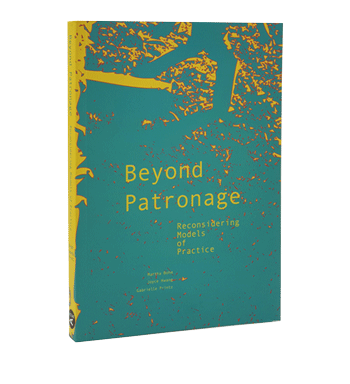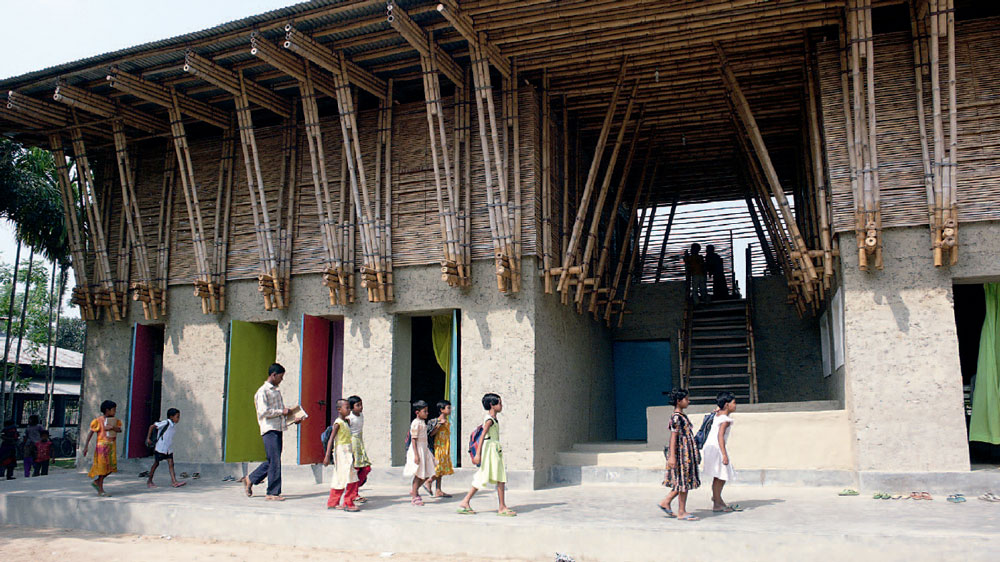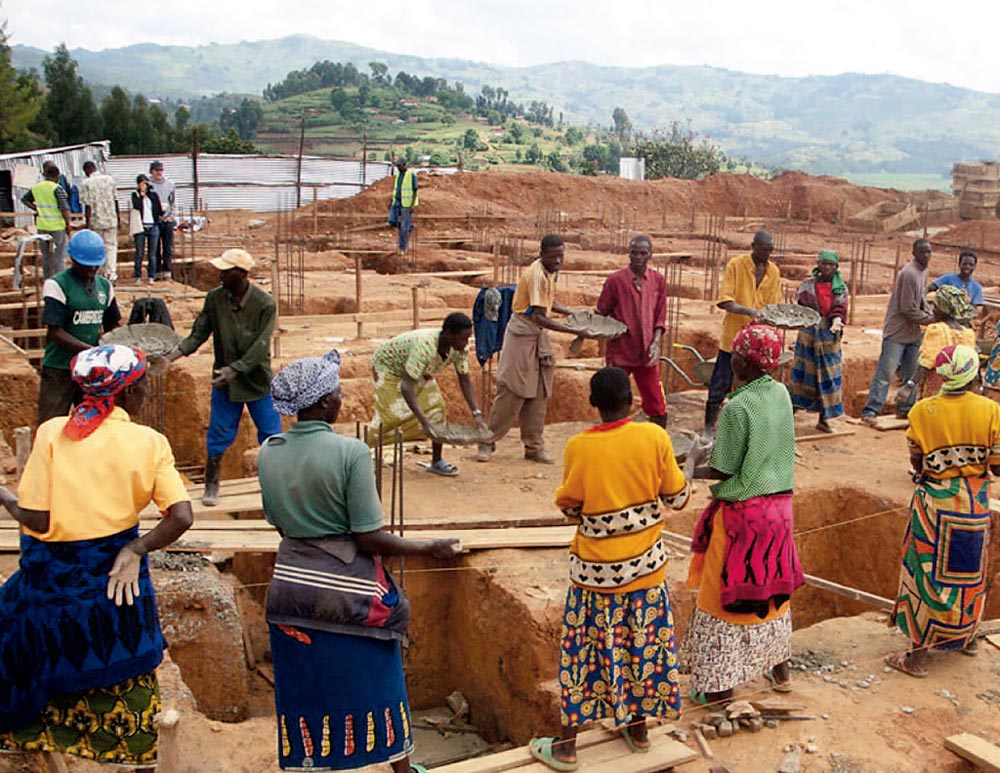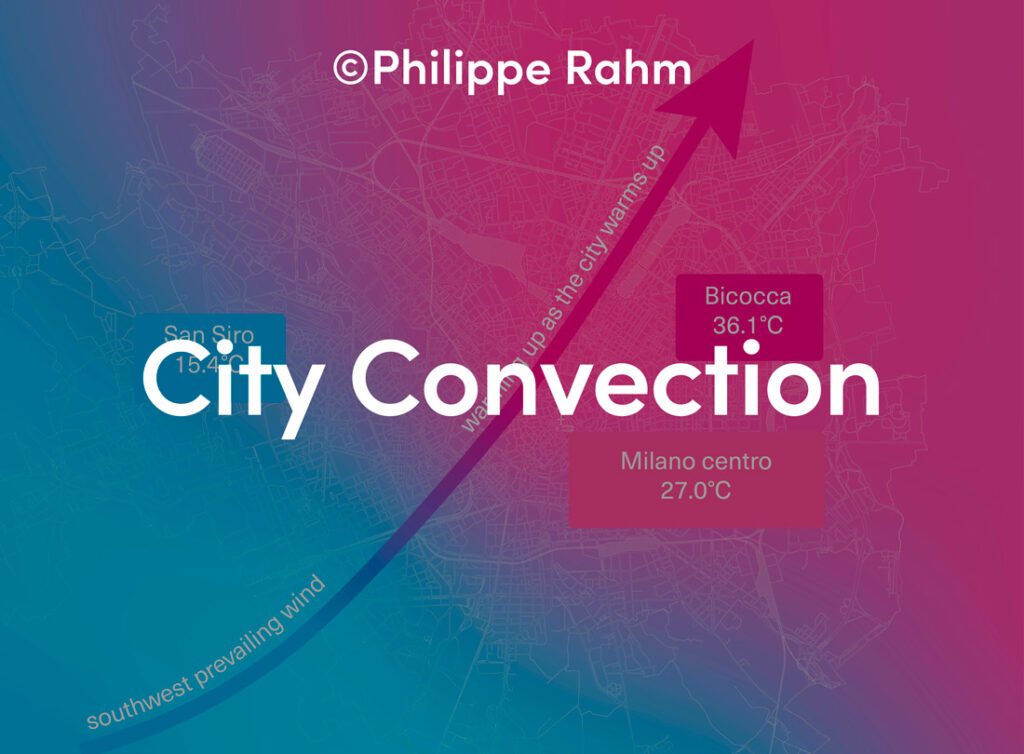To be an advocate—to defend the cause of another or to support the interests of another—is a form of practice that we tend to associate with the realms of politics, law, and social activism. Debates surrounding human rights, civil rights, women’s rights, disability rights, and even animal rights might be the issues that first come to mind when reflecting upon notions of advocacy, but how might an architect operate as an advocate? How might we consider an architectural project as a form of advocacy?
Pro Bono Practices
Perhaps a first tendency in identifying moments of social activism in architecture might be to think of examples of volunteerism. Within recent decades, not-for-profit organizations have played a tremendous role in urging architects to engage with communities in need. The field of architecture itself has seen the emergence of several key organizations in this capacity. Architecture for Humanity, for example, was founded in 1999 to provide opportunities for architects to participate in socially-relevant design projects, competitions, and workshops, including efforts from addressing disaster-relief housing and basic services for those living in poverty to soccer fields and community centers.1 The organization’s mode of practice is to solicit volunteer work by architects. As AfH describes, “By tapping a network of more than 50,000 professionals willing to lend time and expertise to help those who would not otherwise be able to afford their services, we bring design, construction, and development services where they are most critically needed.”2 Another well-known organization, the 1% Pro Bono Design Program of Public Architecture,3 operates similarly. Founded in 2002, Public Architecture, “challenges architecture and design firms nationwide to pledge a minimum of 1% of their time to pro bono service”4 and connects these firms with nonprofit organizations that request assistance. Today, we see an increasing number of organizational models that support pro bono practices alongside profit-driven businesses. The Open Hand Studio,5 for example, is a pro bono arm of Cannon Design, a large multinational firm.6 Through models such as these, the ability for an architect to work as an advocate through socially-minded projects is increasing, due to the sheer quantity of avenues that exist. Looking at the collective track record of such organizations, it is clear that they fill a tremendous gap between architects and the disadvantaged communities which do not typically have access to professional design services.
Yet, volunteerism—as a proposed framework of practicing social advocacy in architecture—implores us to challenge its most fundamental assumptions. Is it sustainable—or even ethical—to rely on the altruism of pro bono services, particularly in times of economic decline? In order for an architect to have extra time for pro bono services, one would typically need to be gainfully enough employed in some other capacity. The amount of time that an architect can afford to spend on socially-motivated projects is therefore relatively minimal, compared to the total amount of time that is spent on profit-generating efforts.7 So, in instances when the practice of advocacy is pursued as a kind of ‘side job,’ is the architect really afforded the time and space to explore design through multiple iterations or tests? Or, does the quality of design suffer, reflecting the limited time that one is able to spend on the project? While it is true that this model of practice has produced a number of well-considered projects, the emphasis in this case remains that architecture as a form of social advocacy is presented as a menu of “service offerings” for ‘solvable’ problems.8 Here, I am not critiquing architecture’s goal to solve problems, as this is in fact one of our profession’s unique abilities and responsibilities. One cannot undervalue the importance of problem-solving, particularly for communities in need. Small, incremental tasks of assistance—from weatherizing a home to renovating a space to be accessible for the disabled and elderly—certainly contribute immensely to enhancing our inhabitable environment. Rather, I am asking: how can we, as architects, expand the practice of advocacy to cultivate further aims and ambitions, in addition to problem-solving?
As architects, we understand the value of aesthetics in defining culture and in drawing public interest to a place or a cause. Yet, it is the rule, rather than the exception, that well-designed buildings and environments are luxuries, more readily available to moneyed clients. Meanwhile, for those without the same financial means, architecture is often relegated to a more limited role. So, while pro bono activity is indeed an admirable form of ‘doing good,’ I believe that it is urgently imperative, for the sake of advancing architecture’s impact on society, to explore how these and other frameworks of advocacy-based practices can more robustly sustain innovative, experimental, and groundbreaking design in the long term, and in the larger economic landscape.
Toward New Frameworks for Practice
How does one pursue advocacy in architecture? How does one cultivate a productive balance between seemingly conflicting priorities, such as social justice and aesthetics, or problem-solving and problematizing? Looking beyond the short-term goals of volunteerism, architects and organizations are starting to develop long-term strategies to undertake socially-charged work. To consider the notion of architects as ‘advocates,’ we can begin by examining several fundamental frameworks for practice.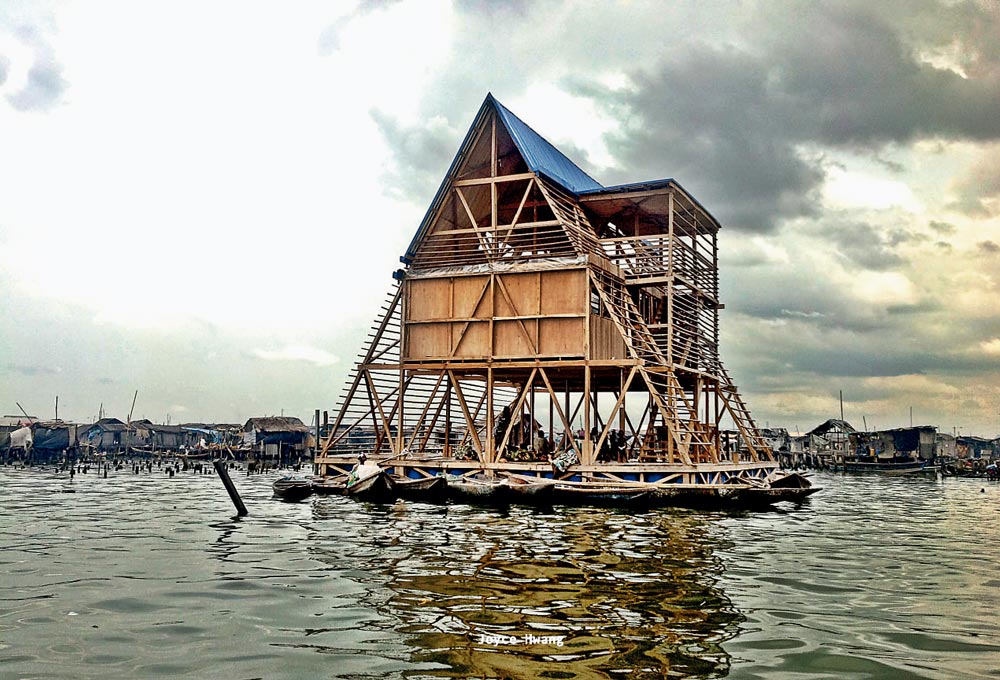
Makoko Floating School, NLÉ
1. Collaborate with Community Organizations
This is a familiar model of collaboration between architects and not-for-profit organizations, and has been infamously energized by Teddy Cruz, now an emblematic figure in the world of activism and architecture. Recognized for his collaborative efforts with Casa Familiar, a community development agency which serves border communities between the United States and Mexico, Cruz and his collaborators have worked with this model to initiate a number of provocative social projects, including a proposal for senior housing and childcare. Today we find a number of designers who, inspired by this model, actively seek alliances with community-based organizations to initiate projects that address social and ecological issues that are left largely unaddressed by market forces. In some cases, these advocacy-based projects are even developed against the grain of officially-sanctioned directives. For example, in Makoko, a waterfront settlement in Lagos, Nigeria, the government has deemed that some of its inhabited areas are dangerous due to the persistent threat of flooding and high waters, and has forced residents of Makoko to relocate. According to The Economist, “The entire district may soon be gone. The government is eager to reclaim what has become prime waterfront land. It is only half-fair to depict it as heartless and greedy. Built on a swamp, Lagos is fighting for survival. Ceaseless migration is strangling it.”9 After speaking with Makoko residents, architect Kunlé Adeyemi pinpointed a specific infrastructural problem—that the local school is constantly flooded—and initiated a different kind of response. With help from the community, and with sponsorship from the Heinrich Böll Foundation and the United Nations, he developed a “floating school” that could resist the environmental challenges faced by the settlement. Designed to serve 100 schoolchildren, the structure is a three-story A-frame building with classrooms, a play area, a rainwater collection system, and composting toilets—all buoyed by a layer of plastic flotation barrels.10 Yet, even with a modest budget, the project does more than satisfy community needs. Within the landscape of Makoko, it stands as a beacon of resilience and hope. As an architectural artifact, it is striking, and brings public attention to the social and political turmoil in Lagos. For a global audience, Adeyemi hopes that this project is a “seed to cultivate a new type of urbanism on water in African cities,”11 to catalyze others to rethink ways of building to address climate change and flooding.
2. Form an Organization-within-an-Institution
Another model of advocacy-based practice is to form an institutional program within a university or a school of architecture. This kind of partnership takes advantage of the influence and resources of universities, and gives architects, faculty, and students of architecture the opportunity to realize projects that are spurred by research interests or other meaningful drivers. The Yale Building Project, an early example conceived of in the 1960s by Charles Moore, organizes first-year graduate students to design and construct a building for underserved ‘clients’ in local communities.12 Auburn University’s Rural Studio, founded by Samuel Mockbee and D.K. Ruth in 1993, is another pioneering example of an organization within an academic institution.13 Over the decades, design-build programs have been taking shape in many schools of architecture in the United States. In 2012, a report issued by the Association of Collegiate Schools of Architecture (ACSA) noted that among the 123 NAAB accredited schools of architecture, there are approximately 100 design-build programs.14 Cited by Architect Magazine as a school that excels in design-build,15 University of Kansas’ Studio 804, led by Dan Rockhill, has formed its own 501c3.16 URBANbuild at Tulane University was initiated in 2005, in response to the socio-economic and environmental landscape of New Orleans after Hurricane Katrina.17 Many schools also offer various design-build courses external to an organized institutional program.
At the University at Buffalo, the Department of Architecture has honed a design-build ethos through its course offerings and multiple faculty initiatives. Most recently, collaborations between faculty members, students, and local manufacturers—such as Rigidized Metals—have yielded the realization of several projects on a formerly abandoned industrial site in Buffalo. In 2012, the Department’s Ecological Practices Research Group organized a competition, “Hive City,” for students to design and build an urban bee habitat, a process which yielded the fabrication of “Elevator B,” a 22-ft tall tower for bees. Later that year, Sergio López-Piñeiro devised a project to reactivate an unused flour warehouse through a simple tactic of painting the building’s columns to suggest an interior topography, transforming a derelict space to one that can be occupied by the public. In 2013, Christopher Romano and Nicholas Bruscia, together with several students, designed and constructed a monumental folded stainless steel wall, 2XmT, to define a gateway to the site as well as to demonstrate the structural potential of textured stainless steel sheet material.
While design-build processes do not always translate neatly to advocacy-based practices, it is worth mentioning that the notion of ‘design-build’ has been, in many cases, synonymous with an activist ethos in architecture. Certainly, the ‘do-it-yourself’ mentality breeds a great sense of empowerment. The practice of ‘tactical urbanism’—initiating small, incremental, often D-I-Y operations in a city to generate more widespread urban consequences—is becoming increasingly championed by forward-thinking designers and urbanists.18
3. Amend Traditional Practice Structures
The third model for advocacy-based practice works within a more traditional framework of architectural design. In this model, architects acquire commissions in standard ways—for example, by working with developers or engaging in competitions. Within these conventional project structures, they interject strategies that promote wellness for the project’s inhabitants or community. A poignant example is Frédéric Druot, Anne Lacaton, and Jean-Philippe Vassal’s transformation of Tour Bois-le-Prêtre, a project to renovate an existing social housing structure, in which the architects developed and choreographed a construction phasing plan that allowed the tower’s residents to remain in their residences while construction occurred. The task of easing the residents’ sense of disruption and discomfort was a tremendous feat—already an indicator of architects acting as social advocates. Eschewing the perceived conflict between formal and social concerns, the architects put forward aesthetics and space as cultural values. They introduced a sense of openness, lightness and dignity to each residence, with full height glass windows and balconies throughout the project’s façade.
Critical Factors Beyond Practice Typologies
The frameworks I just described are, in a sense, easily digestible. They categorize advocacy-based practices in an already-familiar way. One could stop here and suggest that it is possible to simply adopt a particular ‘practice typology’ in order to pursue socially-engaged work. I would like to propose, however, that subscribing to emerging practice models is not enough. The circumstances of projects and their architects reveal a number of other factors that are critical to the development of architecture as advocacy. In their pursuit of advocacy, architects must ultimately confront often difficult and complex questions that address issues of Time, Labor, Urgency, Risk, and Empathy.
METI Handmade School, Anna Heringer + Eike Roswag
1. Time and Labor
Factors of time and labor cost—not only in terms of construction, but also in design—often render ‘architectural services’ cost-prohibitive to many individuals and communities. This reality is typically met with the answer of ‘community engagement’ as a means of enabling a project’s realization. Current discourses surrounding socially-driven architecture have already recognized a number of practices that directly involve community members in fabricating and constructing projects.19 In Gando, Burkina Faso, for example, architect Diébédo Francis Kéré designed a primary school using unbaked mud bricks, a readily available material from the region, and developed a construction process in which community members were trained to use a machine to compress bricks, then assemble them on-site.20 Along similar lines, architects Anna Heringer and Eike Roswag followed a comparable process in building the METI-Handmade School in Rudrapur, Bangladesh, in which the architects developed construction techniques that drew upon local building materials and traditions, and trained resident unskilled laborers to build using these techniques. Further, the intellectual labor—the research and design process—was accomplished while Heringer was a student of architecture, as the project was her master’s thesis.21
It could be argued that time scales may be of less importance to those who are able to produce a steady stream of income through more traditional profit-driven practices. However, time scales are incredibly significant for architects who work through fundraising and grant-writing. The prospect of winning a grant for 10 consecutive years, for example, is more daunting than that of winning grants for two years in a row.
2. Urgency and Risk
Another highly critical factor that distinguishes advocacy-based architecture is the often high degree of urgency and a correlated high level of risk. In extremely urgent scenarios, such as post-disaster relief—a project typology that is frequently embraced by not-for-profit organizations—design practices necessarily thrust themselves to work at breakneck speeds. In situations of extreme urgency, typical standards and codes are often put on hold momentarily. One understands, of course, that a shelter for temporary relief does not need to fulfill every standard that is required for long term housing.
There are many worthwhile architectural explorations in this regard, particularly Shigeru Ban’s efforts in developing and building post-tsunami and post-earthquake housing. Yet, in many other parts of the world, the majority of critical decisions tend to be ‘resolved’ without design intention, often placing ad-hoc provisions ahead of design quality. Think, for example, of the 145,000 FEMA trailers that were deployed after Hurricane Katrina in 2005, a $2.7 billion plan that was later deemed an “official policy of premeditated ignorance” due to the high level of formaldehyde present in the trailers.22 Perhaps a more fertile territory for architecture to address is one that has a sense of urgency, but not the truncated timeframe that follows emergencies or disasters. The previously discussed example of Kunlé Adeyemi’s Makoko Floating School in Lagos stands as a poignant example. The settlement of Makoko suffers from chronic flooding, which affords the government an ‘excuse’ to displace its inhabitants. The pace, budget, and aims of Adeyemi’s project can still be classified as ‘urgent;’ yet there was enough time for the architect to conduct research, engage partners and sponsors, and develop a well-considered and thoughtful design agenda. We see a similar approach in the work of Lateral Office, a Toronto-based firm headed by Lola Sheppard and Mason White, whose work is featured in this section. In their Arctic Food Network project, Lateral Office confronts the complex web of social and environmental issues in the northern territories of Canada, where many problems stem from the lack of infrastructure and connectivity in Arctic regions. They put forward strategies for initiating a food-based network to serve communities there. While this began as a research project that was instigated by social concerns, Sheppard and White have received a number of significant grants to support this work, and are exploring ways to implement their propositions.
What might these types of practices, such as Lateral Office, suggest? How do we identify and address situations of ‘urgency’ in measured ways? Many of these projects emerge through ‘detective work’ conducted in various geographic locations, and quite often involve working in territories outside of one’s immediate context. From these examples, we can understand the challenges of exporting knowledge and techniques into other regions. These practices also grapple with the sensitive questions of how to translate to ‘home’ the specific advocacy-based strategies that are developed in foreign contexts. As we have discussed, construction of many socially-conscious projects has relied on community participation in gathering local materials and fabricating building components. How might we explore ways to export these kinds of hands-on practices to more knowledge-based or industrial economies?
3. Empathy
One might argue that architects, by the nature of the profession, must possess the ability to empathize; that is, to see and feel the world through the embodiment of another. How else would an architect be able to understand the needs and desires of clients, after all? Still, the issue of empathy is perhaps not as centrally located in contemporary architectural discourse as it should be, except perhaps in the area of ‘inclusive design.’ Even in those instances, one often finds the discussion gravitating toward metrics and performance, for example, assessing whether an environment is suitable for those with certain disabilities. I would like to suggest that the notion of empathy must play a more culturally profound—and even provocative—role in design processes that shape advocacy-based architecture.
In the work of Diébédo Francis Kéré, it is not difficult to sense the high level of empathy that he feels toward the people who inhabit his projects, as Kéré himself was raised in Gando. While he maintains a practice in Berlin, he spends much of the year in Burkina Faso, fundraising through a nonprofit foundation that he founded, Building Blocks for Gando. Since finishing architecture school in 2004, he has been tirelessly “build[ing] schools, health clinics, and other civic-minded projects.”23 His passion for helping those in his community can be felt. As Jenna McKnight writes in Architectural Record, “During his rousing lectures, it’s not uncommon for the exuberant architect to jump off the stage or pound on the floor to illustrate a point. His talks typically draw standing ovations.”24
The word “empathic” is underscored by Marika Shiori-Clark, who is currently the Principal of SOSHL Studio, and is one of the founders of MASS Design Group, “an architectural nonprofit dedicated to designing well-built environments that aid in the reduction of global poverty.”25 In her 2011 talk titled “Empathic Architecture,”26 she discussed the trajectory of working with Partners in Health (a Boston-based NGO), along with the Clinton Foundation, the Ministry of Health and other local officials, to design, develop and build the Butaro Hospital in Rwanda. While she and her colleagues initially worked on the project while they were based in Cambridge, Massachusetts, as students at the Harvard Graduate School of Design, the turning point came when they traveled to Rwanda and decided to live at the hospital site. Shiori-Clark recounts:
We show up in Rwanda all of a sudden, wet behind the ears, knowing nothing, architecture students who have never designed a thing in their lives. Pretty much out of desperation and not knowing any better, we decided to set up an office in Rwanda, as a way to try to understand the community. That initial decision, I think, has actually shaped the way we end up running our organization over these last five years… This idea that we really do try to embed ourselves in the community and literally live there on site… we were living on the actual hospital site with the patients, the doctors, and the nurses…trying to, through osmosis, to learn about how people were living on the site.27
Butaro Hospital, under construction, MASS Design Group
This is a case in which an initial sense of sympathy shifted toward empathy as a consequence of the design process. At first, the architects—like many socially conscious others—wanted to use their skills to ‘do good’ by helping a nonprofit organization. After living at length in Rwanda, however, they were able to foster empathy by more deeply experiencing the day-to-day existence of their project’s users.
One could argue that Shiori-Clark’s account of developing empathy tells perhaps the most straightforward way of doing so: to put oneself as close as possible to experiencing the world through the eyes and body of another. At the same time, the perceptual embodiment of another is perhaps one of the most challenging facets of contending with architecture as an advocate for underrepresented, underserved populations. To understand the lives of others outside of one’s own culture and comfort zone requires a nuanced and patient approach, one which grapples not only with tangible experiences, but also with issues of identity, such as culture, ethnicity, race and class. Architects are increasingly confronting these socio-political factors as part of their research agendas. The work of Yolande Daniels, for example—whose current practice Studio SUMO was formed with her partner Sunil Bald—specifically examines the spatial and political landscapes of African-American identity and memory, through processes of revealing nuances of repression in underrepresented populations. In some of her built projects, such as the Museum of Contemporary African Diasporan Art, she directly addresses issues of cultivating identity by bringing a dignified and highly visible presence to a particular cultural institution.
To answer the questions of how one can more intimately understand the complexities that shape identity, and how that understanding can translate to the design process and the designed environment, is not a straightforward path. Ultimately, this is one of the greatest challenges that face architects as advocates. General questions that address issues of advocacy include: How can one truly empathize with and understand the cultural values of others? How can one serve their needs while pushing forward agendas of space and aesthetics? Beyond these general questions, specific questions of identity pertaining to ethnicity, race, gender, and other cultural factors eventually emerge in either overt or nuanced ways. For example, how might an architect’s ethnic identity influence the design of a building’s aesthetic and experiential qualities? Or, how might an architect’s cultural bias shape the formation of project leaders and teams, who, of course, directly impact a project’s development? Indeed, taking on the role of the Architect-Advocate does not simply rest on intentions of ‘doing good.’ Rather, it demands the cultivation of genuine empathy and skill in considering the identities of oneself and others in a world that is driven by commerce and consumption, and sensitivity in a practice that is otherwise driven by the ‘bottom line.’
Architect as Advocate
How might we now understand the role of advocacy in architecture today, and its potential for the future? Several effective practice models have already been set in motion, and continue to evolve. Yet, I will argue that the Architect as Advocate must progress beyond the task of innovating a practice model, and also begin to navigate the complex milieu of time, labor, risk, urgency, and empathy, to develop concrete agendas, strategies, and modes of production. Thus, architects can indeed become agents of societal change. As we see in the work of Lateral Office, Studio SUMO, and many others, Architects as Advocates are actively establishing larger social, political, and economic agendas in their work. As such, they are changing the status quo in practice and reshaping the construction of identity and power in the field.
